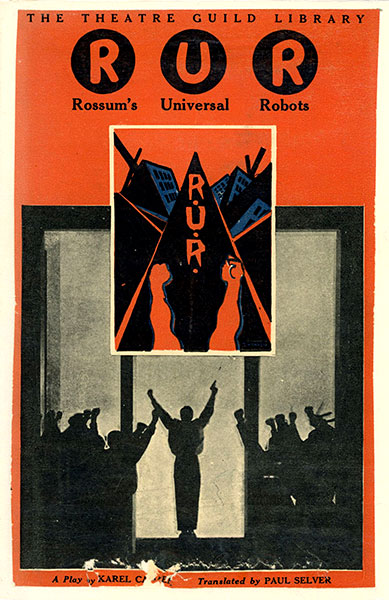translated/adapted by Paul Selver and Nigel Playfair
R.U.R. Introduction: Profit and the End of the World
 |
| Theatre Guild Library edition slip cover. |
|
The Brothers Capek Blackbird Notes From the Theatre Guild ed. |
|
Though automata, puppets, golems, and other imagined constructions or creations of the material and animate humanoid body existed before Rossum’s Universal Robots, it was R.U.R. that brought the word “robot” into wide and persistent use just over one hundred years ago. That word, from the Czech robota is thanks to the author’s brother Josef (himself a writer, artist, and book cover designer). An account of Josef Čapek’s suggestion to use the word “robot” appears in the menu under “Inventing Roboti.” (Roboti is the plural form.)
The Oxford English Dictionary entry for “robot” confirms the word’s link to R.U.R.
Etymology: < Czech robot (1920 in R.U.R.: Rossum’s Universal Robots, a play by Karel Čapek (1890–1938), Czech author) < robota forced labour, drudgery (see robot n.1). Compare French robot (1924) and (with German -er -er suffix1) German Roboter (1922). Compare earlier robot n.1
Josef and Karel would collaborate on a number of plays and books together though Josef’s chief contribution to R.U.R., besides offering the word “robot,” was as the book’s editor and cover designer. A selection of Josef’s covers for editions of R.U.R. in Czech and foreign editions are republished here.
The question of how close English language editions are to Karel Čapek’s original is treated briefly with images of the play’s ending from three different English language editions (and the Czech) under “Variant Editions.” The general consensus appears to be that the play was adapted—and even bowdlerized—rather freely.
The Theatre Guild edition, presumably the text used for the New York 1922 performance, includes prefatory material of interest. We are republishing the New York cast list, the translator’s introduction, and a producer’s note.
Reviews in U.S. papers were mixed, and Karel Capek’s country of origin was given variously as Hungary and Russia, leading to such commentary as “Russians at Large,” which appears here among a brief sampling of reviews.
The Samuel French edition we republish in Blackbird’s pages appears to be an adaptation of Paul Selver’s translation published by the Theatre Guild, though it is co-attributed to Playfair. For readers who want to read R.U.R. and its variants, all editions we cite can be found in online digital repositories such as the Internet Archive and the HathiTrust Digital Library. Those curious about getting closer to Karel Čapek’s original text, short of reading it in Czech, would be advised to study later unabridged translations.
The self-destruction of the human race is an old, and ongoing story; R.U.R. is a play, in part, about how profit motive brings the end of humanity (if under the guise of improving the human condition). Rossum's factory creates sentient enslaved individuals who ultimately overpower and destroy their masters/makers. A parallel plot point of population-wide sterility, even as robots are being created in huge numbers, further ensures the collapse of human civilization.
R.U.R. is certainly a melodrama, and was read by critics as such even in the 1920s, but it is, nonetheless, a relevant melodrama, if to see how ideas of labor, servitude, technology, and self-destructive impulses manifested in the imagination of a Czech author over one hundred years ago. Tropes it invokes are ones still very much with us today, even at a time where actual robots exist (whether industrial machines, animal or humanoid mechanical bodies, cyborgian prosthetics, or “immaterial” algorithms we use daily on devices and in the cloud). Equally, or perhaps even more pervasive in our culture, and owing to R.U.R, are robots as central characters in literature, plays, television, and film—sometimes beloved, often terrifying.
We keep telling stories about the end of the human race, or of the world. In the 2021 film, Don’t Look Up, the plan to destroy a comet on collision course with Earth is abandoned when the comet is disovered to contain trillions of dollars of rare earth minerals. The revised plan is to send a fleet of drones (arguably—if incidentally here—robots) to fragment the comet so that the material can be retrieved from Earth's oceans. Some rockets carrying the devices explode on the pad; drones landing on comet go ary, and the entire effort fails as the world watches in real-time. In this satiric allegory on climate change, profit motives and greed lead to Earth's destruction. So too, as the fate of humanity becomes clear in R.U.R., Domin, the robot factory owner, tries to justify the creation of the robots to Alquist, who very soon will be the only surviving human being on Earth.
DOMIN (From window)
Alquist, this is our last hour. We are already speaking half in the other world. That was not an evil dream to shatter the servitude of labor. The dreadful and humiliating labor that man had to undergo. Work was too hard. Life was too hard. And to overcome that—ALQUIST
Was not what the two Rossums dreamed of. Old Rossum only thought of his Godless tricks, and the young one of his milliards. And that’s not what your R. U. R. shareholders dream of either. They dream of dividends, and their dividends are the ruin of mankind.
Contributor’s notes: Karel Čapek
Contributor’s notes: Josef Čapek